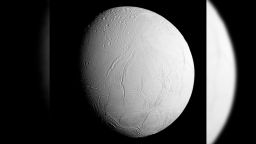Sign up for CNN’s Wonder Theory science newsletter. Explore the universe with news on fascinating discoveries, scientific advancements and more.
Ocean worlds in our solar system are attractive places in the search for life beyond Earth.
Beneath a thick, icy shell, Jupiter’s moon Europa and Saturn’s moons Titan and Enceladus likely harbor oceans, scientists believe. On Earth, the oceans teem with life, but is the same scenario possible on these frosty moons?
Future missions could reveal if ocean worlds are habitable, and if so, what kind of life could exist below the ice. Orbiters such as NASA’s Europa Clipper and the European Space Agency’s Jupiter Icy Moons Explorer will fly by Europa this decade, and a rover-size drone called NASA’s Dragonfly will launch in 2027 to reach Titan in the 2030s.
Scientists who authored the 2022 planetary decadal survey have recommended sending the Orbilander mission to Enceladus, which would both orbit and land on Saturn’s tiny moon in the 2050s.
But exploring the challenging terrain as well as the oceans themselves may require technology that seems more like science fiction.
Here are some of the concepts experts are exploring at NASA’s Jet Propulsion Laboratory in Pasadena, California, that could one day transform into a mission diving beneath the ice on alien worlds.
Ice hopping
Little is known about the frozen terrain covering Europa and Enceladus, so any mission exploring the surface of these worlds could potentially have to navigate treacherous landscapes.
A concept called SPARROW, or the Steam Propelled Autonomous Retrieval Robot for Ocean Worlds, would be able to hop right over any hazards such as long ice blades called penitentes.
“The terrain on Europa is likely highly complex,” said Gareth Meirion-Griffith, JPL roboticist and lead researcher of the concept, in a statement. “It could be porous, it might be riddled with crevasses, there might be meters-high penitentes that would stop most robots in their tracks. But SPARROW has total terrain agnosticism; it has complete freedom to travel across an otherwise inhospitable terrain.”

The concept includes a lander that acts as a home base for a spherical robot. This ball, which resembles a cage and is about the size of a soccer ball, would include instruments and thrusters.
Rather than relying on fuel, the SPARROW ball would use steam created from melting ice. The low gravity on ocean worlds would allow the ball and its steam-powered thrusters to hop for miles.
The lander would collect and melt the ice, then load water into SPARROW. The robotic ball’s engines could warm the water to create a steam boost.
Instruments aboard SPARROW could be used to collect samples that could be analyzed on the lander.
And more SPARROWs may be better than one to explore these mysterious, distant worlds.
Roving underwater
Since 1997, scientists have used rovers to study Mars and uncover intriguing details about its habitability in the past.

The Buoyant Rover for Under-Ice Exploration, or BRUIE, would act in much the same way – just inside an ocean on Enceladus or Europa, rather than on land.
A rover exploring an ocean world will need to navigate on its own. The BRUIE prototype is about 3 feet (1 meter) long and has two wheels to help it roll upside down along ice. Images and data collected by the floating rover will allow scientists to study the “ice-water interface.”
“We’ve found that life often lives at interfaces, both the sea bottom and the ice-water interface at the top. Most submersibles have a challenging time investigating this area as ocean currents might cause them to crash, or they would waste too much power maintaining position,” said Andy Klesh, lead engineer for the concept, in a statement.
“BRUIE, however, uses buoyancy to remain anchored against the ice and is impervious to most currents. In addition, it can safely power down, turning on only when it needs to take a measurement, so that it can spend months observing the under-ice environment.”

Engineers at JPL have already put the rover through its paces in similar environments on Earth in the Arctic, Alaska and Antarctica.
“The ice shells covering these distant oceans serve as a window into the oceans below, and the chemistry of the ice could help feed life within those oceans,” said Kevin Hand, JPL lead scientist for the BRUIE project, in a statement. “Here on Earth, the ice covering our polar oceans serves a similar role, and our team is particularly interested in what is happening where the water meets the ice.”
Swimming beneath the ice
A small but mighty approach is a concept that would pack cell phone-size swimming robots inside a probe called a cryobot that could melt through the ice crust on Europa and Enceladus. Once underwater, the fleet of tiny swimmers could freely explore the alien ocean.
The Sensing With Independent Micro-Swimmers, or SWIM, concept has received $600,000 funding in the second phase of NASA’s Innovative Advanced Concepts program, which will allow for testing of prototypes.

“My idea is, where can we take miniaturized robotics and apply them in interesting new ways for exploring our solar system?” said Ethan Schaler, a robotics mechanical engineer at JPL, in a statement. “With a swarm of small swimming robots, we are able to explore a much larger volume of ocean water and improve our measurements by having multiple robots collecting data in the same area.”
Each swimming bot would be about 5 inches (12.7 centimeters) long, and about four dozen of them could fit inside part of a cryobot measuring 10 inches (25.4 centimeters) in diameter. There would still be room for science instruments within the probe, which will rely on a hot nuclear battery to melt the ice.
The cryobot’s home base would be a lander on the surface, which would serve as a communications relay between the probe and Earth.
The swimming robots would each have their own propulsion, computer and ultrasound communication, as well as sensors that can record temperature, pressure, acidity and salinity. During the second phase, Schaler will add chemical sensors that could search for signs of life.
“What if, after all those years it took to get into an ocean, you come through the ice shell in the wrong place? What if there’s signs of life over there but not where you entered the ocean?” said SWIM team scientist Samuel Howell of JPL, who also works on the Europa Clipper. “By bringing these swarms of robots with us, we’d be able to look ‘over there’ to explore much more of our environment than a single cryobot would allow.”








